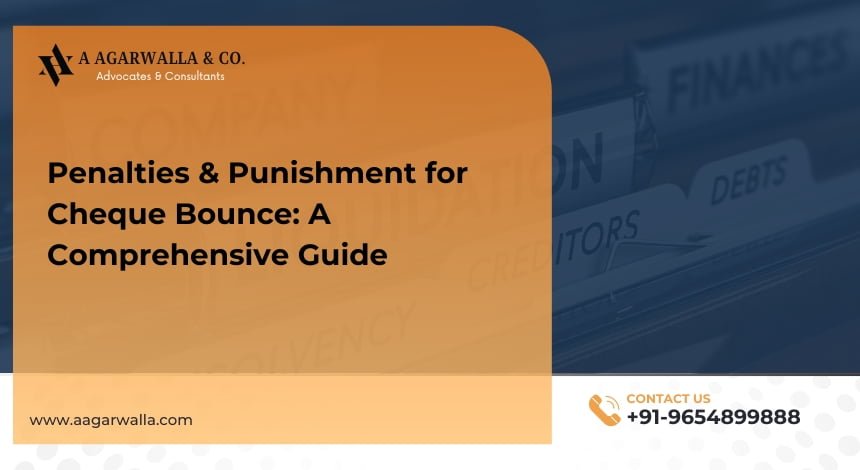What are the penalties for cheque bounce? You can face penalties for cheque bounce when a cheque issued, was dishonoured by the bank due to insufficient funds or other reasons. The penalties for cheque bounce in India are severe and can have significant legal and financial effects on the issuer.
Under Section 138 of the Negotiable Instruments Act, if a cheque is bounced, the payee has the right to initiate legal proceedings against the drawer. The penalties for cheque bounce include a monetary fine that can extend to twice the amount of the cheque, and/or imprisonment for a term that may extend to two years.
Understanding the penalties and punishments for cheque bounce in India is crucial to avoid the pitfalls associated with dishonoured cheques. The legal framework is designed to ensure the integrity of financial transactions and to protect the rights of the payee. By maintaining proper banking practices and ensuring sufficient funds are available, one can avoid the legal issues and financial penalties associated with cheque bounce.
What is Cheque Bounce?
A cheque bounce occurs when a cheque cannot be processed due to insufficient funds in the drawer’s account or due to discrepancies in the details provided on the cheque. This issue is a significant concern in financial transactions, leading to both legal and financial effects for the drawer.
Cheque bounce is defined under the Negotiable Instruments Act, 1881, under Section 138. According to this section, a cheque is considered bounced if it is returned by the bank unpaid due to:
- Insufficient funds in the drawer’s account.
- Discrepancies in the signature on the cheque.
- Mismatched figures and words in the amount section.
- Stale cheques are presented after their validity period (usually three months).
- Incorrect account details.
Legal Framework Governing Cheque Bounce in India
Section 138 of the Negotiable Instruments Act, 1881, specifically deals with the dishonor of cheques. According to this section, if a cheque is dishonored for reasons such as insufficient funds or the account is closed, the payee must send a written notice to the drawer within 30 days from the date of the memo accompanying the bounced cheque from the bank. The drawer then has 15 days to settle the payment. If the drawer fails to make the payment within this period, the payee can file a complaint in a court of law.
The punishment for cheque bounce in India can include a monetary fine, which may extend to twice the amount of the cheque, or imprisonment for a term that may be up to two years or both. The legal consequences of cheque bounce also include damage to the drawer’s financial reputation and potential civil liabilities.
Understanding these legal aspects is crucial for both issuers and recipients of cheques. By being aware of the legal consequences of cheque bounce, one can take necessary precautions to avoid such situations.
Penalties for Cheque Bounce in India
Section 138 of the Negotiable Instruments Act
Section 138 of the Negotiable Instruments Act, 1881 is the cornerstone of the legal framework addressing penalties for cheque bounce in India. This section makes it a criminal offence to issue a cheque that is dishonored due to:
- Insufficient funds in the drawer’s account.
- Signature mismatch.
- Any other reason that results in the cheque not being honoured
Under this section, if a cheque is returned unpaid, the drawer can face imprisonment for up to two years, or a fine that can be twice the amount of the cheque or both. The section ensures strict legal consequences for the defaulter to deter the occurrence of cheque bounce incidents.
Procedure Under Section 138
- Cheque Return Memo: Upon dishonour, the drawee’s bank issues a cheque return memo to the payee, explaining the reasons for the bounce.
- Notice to Drawer: The payee must send a written notice to the drawer within 30 days of receiving the cheque return memo, demanding payment of the cheque amount.
- Drawer’s Response: The drawer has 15 days from the receipt of the notice to settle the payment.
- Filing Complaint: If the drawer fails to pay within the stipulated time, the payee can file a criminal complaint under Section 138 within one month of the 15-day period.
Section 143A: Interim Compensation
Section 143A was introduced to provide interim relief to the complainant during the pendency of the case. This section allows the court to direct the drawer to pay interim compensation to the payee, which can be up to 20% of the cheque amount. This provision ensures that the payee receives some form of compensation while the legal proceedings are ongoing.
In the case of M/S Meters and Instruments Private Limited & Anr vs Kanchan Mehta, the Supreme Court highlighted the importance of imposing strict penalties to prevent the misuse of cheques.
Steps to take After Cheque Bounce
Steps Taken by the Drawee’s Bank
When a cheque bounce occurs, the first step is taken by the drawee’s bank, which issues a cheque return memo to the payee. This memo lists the reasons for the cheque dishonour, such as insufficient funds, signature discrepancies or other errors. The bank also returns the dishonoured cheque to the payee along with the memo.
Actions Required by the Payee
Upon receiving the cheque return memo, the payee must follow a specific legal procedure to address the cheque bounce legal consequences:
- Issuing a Notice: The payee must issue a formal notice to the drawer within 30 days of receiving the cheque return memo. This notice should clearly state the amount due and demand payment within 15 days of receiving the notice.
- Waiting Period: The drawer has 15 days from the receipt of the notice to make the payment. If the drawer fails to comply, the payee has the right to take legal action.
- Filing a Complaint: If the payment is not received within 15 days, the payee can file a criminal complaint under Section 138 of the Negotiable Instruments Act. This complaint must be filed within one month after the 15-day period.
Court Proceedings and Possible Outcomes
Once the complaint is filed, the court issues a summons to the drawer to appear and respond to the complaint. The court proceedings involve the following steps:
- Summons to Drawer: The court sends a summons to the drawer, requiring their presence in court.
- Evidence Presentation: Both parties present their evidence and arguments. The payee must prove that the cheque was dishonored and that the notice was duly issued.
- Interim Compensation: Under Section 143A, the court can order the drawer to pay interim compensation up to 20% of the cheque amount to the payee during the trial.
- If the court finds the drawer guilty, they may be sentenced to imprisonment for up to two years or fined up to twice the amount of the dishonored cheque, or both.
This timeline and process ensure that the legal consequences of a cheque bounce are addressed systematically.
Conclusion
Understanding the penalties for cheque bounce in India is crucial for both the issuers and recipients of cheques. The legal framework under Section 138 of the Negotiable Instruments Act, 1881, outlines stringent penalties, including imprisonment for up to two years, fines up to twice the amount of the cheque, or both. The procedural steps, from receiving a cheque return memo to filing a criminal complaint, provide a systematic approach to address and resolve such issues.
For expert guidance and effective solutions regarding cheque bounce issues, consult A Agarwalla & Co. Our experienced team specializes in handling cases under Section 138 of the Negotiable Instruments Act, 1881 and can provide comprehensive assistance in navigating the legal landscape. Whether you need help with drafting notices, filing complaints or defending against cheque bounce charges, we offer personalized legal support to protect your financial interests and maintain your reputation.
Frequently Asked Questions
1. What are the penalties for cheque bounce under Indian law?
Under Section 138 of the Negotiable Instruments Act, 1881, the penalties for cheque bounce are severe to ensure the credibility of financial transactions. These penalties include a monetary fine, which can extend to twice the amount of the bounced cheque. Additionally, the drawer may face imprisonment for a term that may extend to two years.
2. How can one avoid cheque bounce penalties?
To avoid cheque bounce penalties, individuals should ensure that there are always sufficient funds in their account before issuing a cheque. Regularly monitoring bank account balances and setting up alerts for low balances can help prevent unintentional overdrafts. Avoiding the issuance of post-dated cheques unless certain of future funds and ensuring accurate cheque details such as date, amount, and signature are also crucial.
3. What are the legal consequences of a cheque bounce?
The legal consequences of cheque bounce are quite extensive and can significantly affect the drawer. Upon the dishonor of a cheque, the payee can initiate legal proceedings under Section 138. This can lead to a criminal record for the drawer, impacting their reputation and financial standing.
4. What happens if a cheque bounces and the drawer fails to respond to the legal notice?
If a cheque bounces and the drawer fails to respond to the legal notice within 15 days, the payee has the right to file a complaint under Section 138 of the Negotiable Instruments Act, 1881. This can lead to court proceedings where the drawer may face cheque bounce imprisonment for up to two years and a cheque bounces fine up to twice the amount of the cheque.
5. What should I do immediately after my cheque bounces?
If your cheque bounces, the first step is to communicate promptly with the payee and understand the reason for the dishonor. Ensure that sufficient funds are available and try to settle the payment as soon as possible to avoid cheque bounce penalties.


